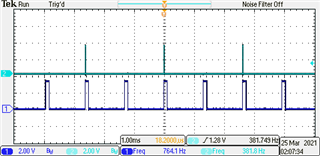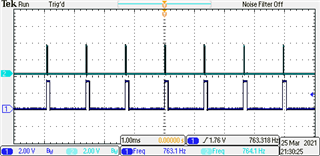Why does the ADC ISR only run every other ADC Trigger which is the Timer A0_1 source.
In the picture below
CH1 is the Timer A0_1 out which is the ADC trigger source and CH2 is an output bit togged on and off inside the ADC ISR.

Code is shown below.
#include "msp.h"
uint16_t resultsBuffer[2];
void main(void){
WDT_A->CTL = WDT_A_CTL_PW | WDT_A_CTL_HOLD;
P5->SEL1 |= BIT5 | BIT4; // Set P5.5 as ADC input A0 and P5.4 as ADC input A1
P5->SEL0 |= BIT5 | BIT4; // Set P5.5 as ADC input A0 and P5.4 as ADC input A1
// initialize P1.0 for Output
P1->DIR |= 0b00000001; // Set P1.0 Output pin
P1->OUT &= ~1; /* turn off P1.0 */
// initialize P2.4 and make it a timer output
P2->DIR |= 0b00010000; // Set P2.4 as an Output pin
P2->SEL0 |= 0b00010000; // Set P2.4 as Primary function Timer_A0_C1 CCR0 Output
// initialize P4.2 and make it a timer output
P4->DIR |= 0b00000100; // Set P4.2 as an Output pin
P4->SEL0 |= 0b00000100; // Set P4.2 as Primary function ACLK
CS->KEY = CS_KEY_VAL;
CS->CTL1 |= CS_CTL1_SELA_2;
CS->KEY = 0;
ADC14->CTL0 &= ~ADC14_CTL0_ENC; // Reset ENC bit for configuration
//Timer_A0 output 1 trigger, Sampling timer is the source of sampling signal, multi channel-repeated conversion mode, Sample and hold time is 8 ADC clock cycles, ADC14 on
ADC14->CTL0 = ADC14_CTL0_SHS_1 | ADC14_CTL0_SHP | ADC14_CTL0_CONSEQ_3 | ADC14_CTL0_SHT0_1 | ADC14_CTL0_ON;
ADC14->MCTL[0] = ADC14_MCTLN_VRSEL_0 | ADC14_MCTLN_INCH_0; // Vcc - Vss references, input channel A0, End of sequence
ADC14->MCTL[1] = ADC14_MCTLN_VRSEL_0 | ADC14_MCTLN_INCH_1 | ADC14_MCTLN_EOS; // Vcc - Vss references, input channel A1, End of sequence
ADC14->IER0 = ADC14_IER0_IE1; // ADC interrupt enabled for ADC14->MEM[1]
ADC14->CTL0 |= ADC14_CTL0_ENC; // Start conversion-software trigger
TIMER_A0->CCR[0] = 42; // PWM period
TIMER_A0->CCR[1] = 4; // CCR1 PWM duty cycle
TIMER_A0->CCTL[1] = TIMER_A_CCTLN_OUTMOD_6; // CCR1 set/reset
TIMER_A0->CTL = TIMER_A_CTL_TASSEL_1 | TIMER_A_CTL_MC_1 | TIMER_A_CTL_CLR; // ACLK, Up mode, Clear TAR
NVIC->ISER[0] = 0x01000000; // ADC14 interrupt is enabled in NVIC
__enable_irq(); // All interrupts are enabled
SCB->SCR |= SCB_SCR_SLEEPONEXIT_Msk; // Sleep on exit
__sleep(); // enter LPM0
}
// ADC14 interrupt service routine
void ADC14_IRQHandler(void){
P1->OUT |= 1; /* turn on P1.0 */
if (ADC14->IFGR0 & ADC14_IFGR0_IFG1){
resultsBuffer[0] = ADC14->MEM[0];
resultsBuffer[1] = ADC14->MEM[1];
P1->OUT &= ~1; /* turn off P1.0 */
__no_operation();}
}



